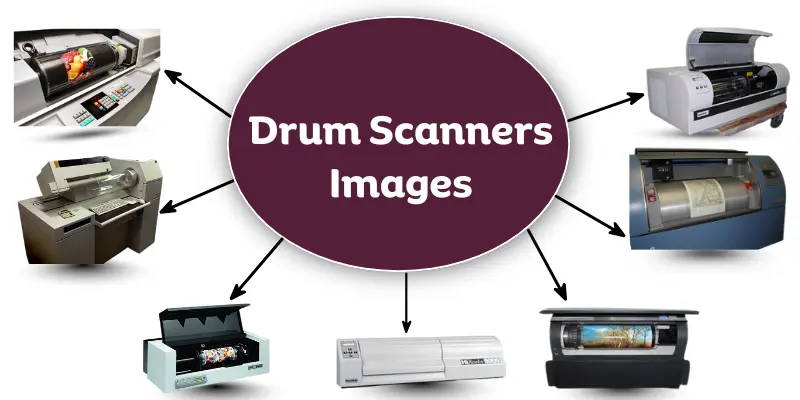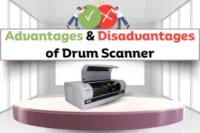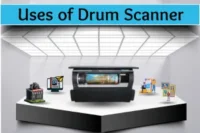What is Drum Scanner – Complete Easy Guide for Beginners
Published: 4 Oct 2025
What is drum scanner? It is a special type of scanner made for very clear and detailed images. People use it when they need top-quality scans, such as in printing or archives. A drum scanner works with a spinning drum and light to capture tiny details. In this guide, we will explain what a drum scanner is, how it works, its features, uses, pros, and cons.

What is Drum Scanner? – Simple Definition
A drum scanner is a high-quality scanning machine. It uses a round glass drum to hold the image. The drum spins while light and sensors read the details. This process creates a very sharp digital copy of the image. People call it a “drum” scanner because the image is fixed on a drum-shaped surface, not on a flat glass like other scanners.
History of Drum Scanner
Drum scanners have a long and exciting past. They started as simple machines and slowly became powerful tools for high-quality image scanning.
1847 – The Early Idea of Drum Scanning
Drum scanning started in the mid-1800s. In 1847, Frederick Bakewell built an early fax machine that used a rotating drum. His invention was not a real scanner, but it showed how images could be read and sent using a drum system. This idea later helped in the creation of true drum scanners.
1937–1946 – The First Real Drum Scanner
The first real drum scanner came in 1937 at Eastman Kodak. Alexander Murray and Richard Morse designed it mainly for color printing. In 1946, a company called P.D.I. improved the design by adding photomultiplier tubes and better color correction. This made drum scanners more accurate and very popular in the printing industry.
1957 and Beyond – The Digital Revolution
In 1957, Russell A. Kirsch and his team made the first digital drum scanner. It could save scanned images directly on a computer, and the first image was a photo of his son. Over time, flatbed scanners became cheaper and faster, but drum scanners remained the top choice for high-resolution and museum-quality work.
Key Features of Drum Scanner
A drum scanner has many strong features that make it different from normal scanners. It captures tiny details and real colors, which is why professionals love it. Here are its main features explained in a simple way:
- High Image Quality – You get really clear and sharp pictures every time.
- Optical Resolution – It sees all the tiny lines and dots you might miss.
- Large Color Depth – Colors look real and rich, not flat.
- Transparent and Reflective Scanning – You can scan slides, negatives, or shiny photos easily.
- Professional Use in Printing – Printing companies rely on it for the best results.
- Scans Very Detailed Images – Even fine textures and patterns show up clearly.
- Handles Different Media Types – Works with paper, photos, slides, and negatives without trouble.
- Accurate Color Reproduction – The colors match the original exactly, just like magic.
How Does a Drum Scanner Work?
A drum scanner works in a unique way to capture very detailed images. It is different from normal flatbed scanners. The drum spins while the scanner reads every small detail. This process gives very sharp and accurate digital copies.
Step-by-Step Working Process:
Image is Placed on Drum
The photo or negative is carefully attached to the drum. This keeps it stable during scanning. Proper placement ensures accurate results.
Drum Spins at High Speed
The drum rotates smoothly while scanning. This allows the scanner to read every part of the image. High speed ensures efficiency.
Light Reads the Image
A strong light passes over the image. It reflects the details to the sensors. This helps capture tiny features clearly.
Photomultiplier Tubes (PMTs) Capture Details
Sensors called PMTs collect all the details and colors. They pick up even the smallest elements of the image. This creates very sharp digital data.
Computer Stores the Final Digital File
The scanner sends the data to a computer. The image is saved as a high-quality digital file. Now it is ready for editing or printing.
Uses of Drum Scanner
Drum scanners give very clear and detailed images. People use them where high quality really matters. Here are the drum scaner uses to understand better.
- You can make photos look perfect for magazines.
- It helps capture every detail for publishing work.
- Museums use it to keep old photos safe.
- Designers get exact colors for their projects.
- Photographers scan slides and negatives clearly.
- Scientists get sharp images for research.
- It makes ads and marketing visuals bright and crisp.
Advantages and Disadvantages of Drum Scanner
Drum scanners are very powerful and give amazing image quality. But they are not perfect for everyone. Let’s see their main advantages and disadvantages in a simple way for better understanding.
| Advantages of Drum Scanner |
|---|
|
Here are the main benefits of using a drum scanner.
|
| Disadvantages of Drum Scanner |
|---|
|
Here are some main drawbacks you should know before using a drum scanner.
|
Conclusion
So, guys, now let’s wrap up what we have learned about what is drum scanner. We saw how it captures tiny details, shows real colors, and helps professionals in printing and design. Drum scanners are powerful, but they need space and cost more. If you want perfect scans, this guide on drum scanner will help you choose the right one. Share it with friends who want clear images too!
FAQs about What is Drum Scanner
Here are some common questions beginners often ask about drum scanners. We answer them in simple words to make it easy to understand.
Yes, a drum scanner can scan large images. The image is wrapped around the drum or attached carefully. It captures every detail, even in big photos. Professionals use it for posters, artwork, and large documents.
It can take more time than a normal scanner. The drum spins slowly to capture all tiny details. High resolution scanning needs patience. But the result is very sharp and clear.
Yes, drum scanners need software to control scanning and save files. The software also adjusts colors and brightness. Most professional scanners come with compatible software. It helps get the best image quality.
Yes, drum scanners can scan delicate photos safely. You need to handle the image carefully. Professionals often use protective covers or soft attachments. This prevents damage while scanning.
Drum scanners capture higher detail and color accuracy. They use a spinning drum and special sensors. Flatbed or sheetfed scanners are faster but less sharp. Drum scanners give professional-quality images.
Drum scanners need regular cleaning and checks. Professionals often maintain them monthly or after heavy use. Sensors and the drum need care to stay accurate. Proper maintenance keeps scans sharp and precise.
It depends on your needs. They are expensive and need space. But if you need very high-quality images, they are useful. For casual or small tasks, cheaper scanners may work better.

- Be Respectful
- Stay Relevant
- Stay Positive
- True Feedback
- Encourage Discussion
- Avoid Spamming
- No Fake News
- Don't Copy-Paste
- No Personal Attacks

- Be Respectful
- Stay Relevant
- Stay Positive
- True Feedback
- Encourage Discussion
- Avoid Spamming
- No Fake News
- Don't Copy-Paste
- No Personal Attacks



